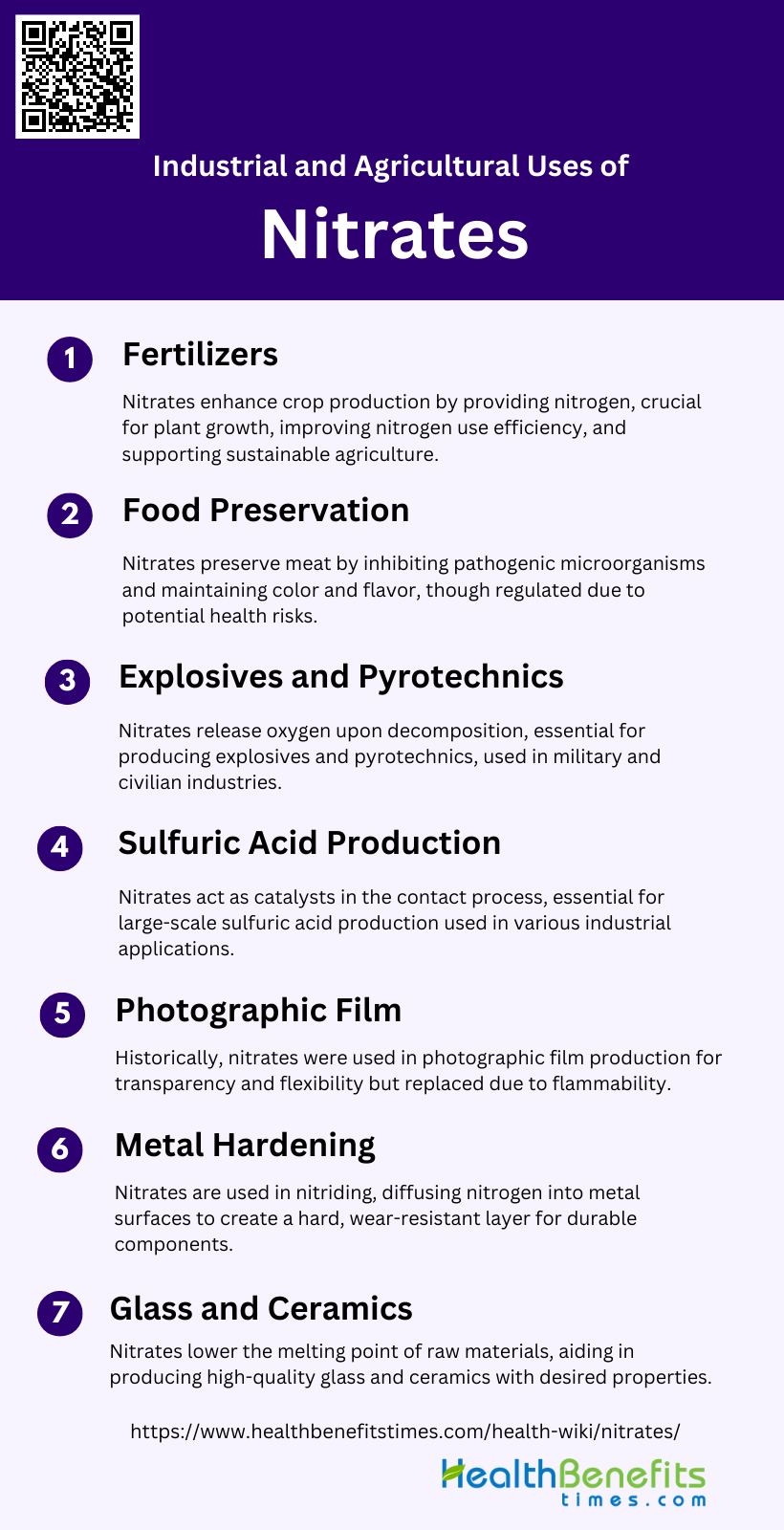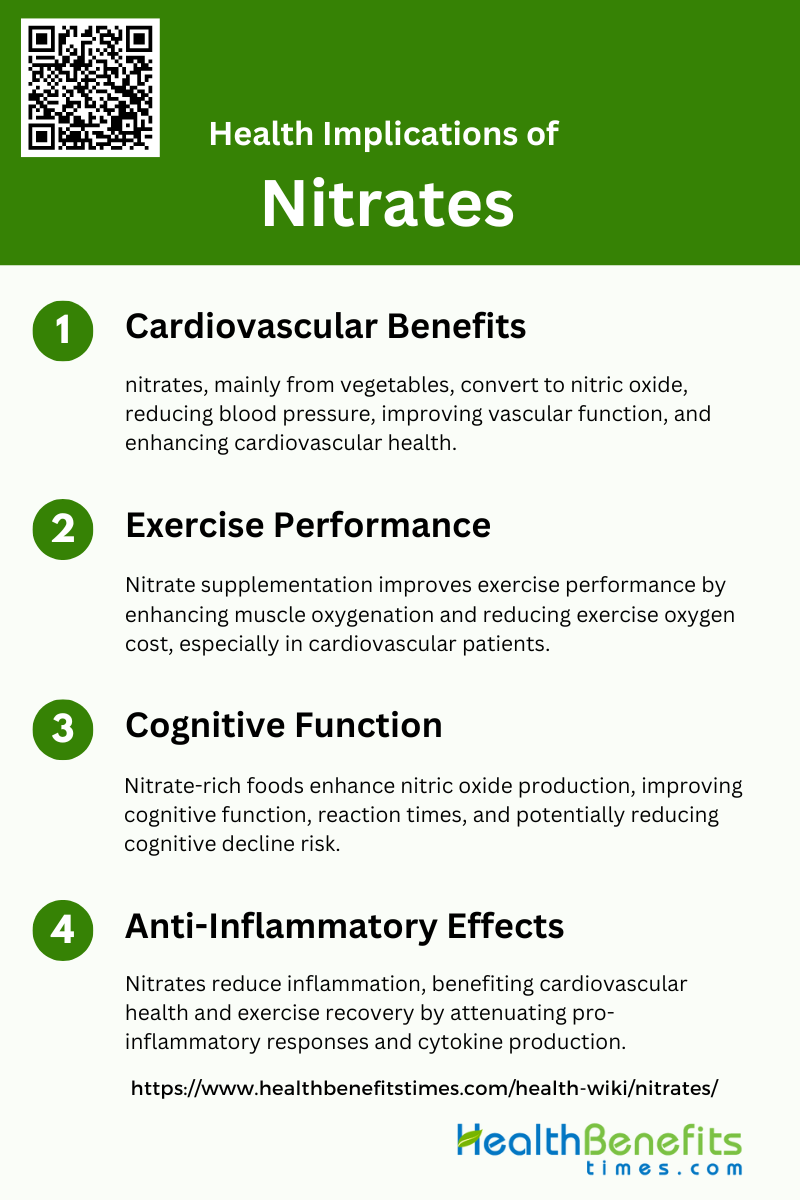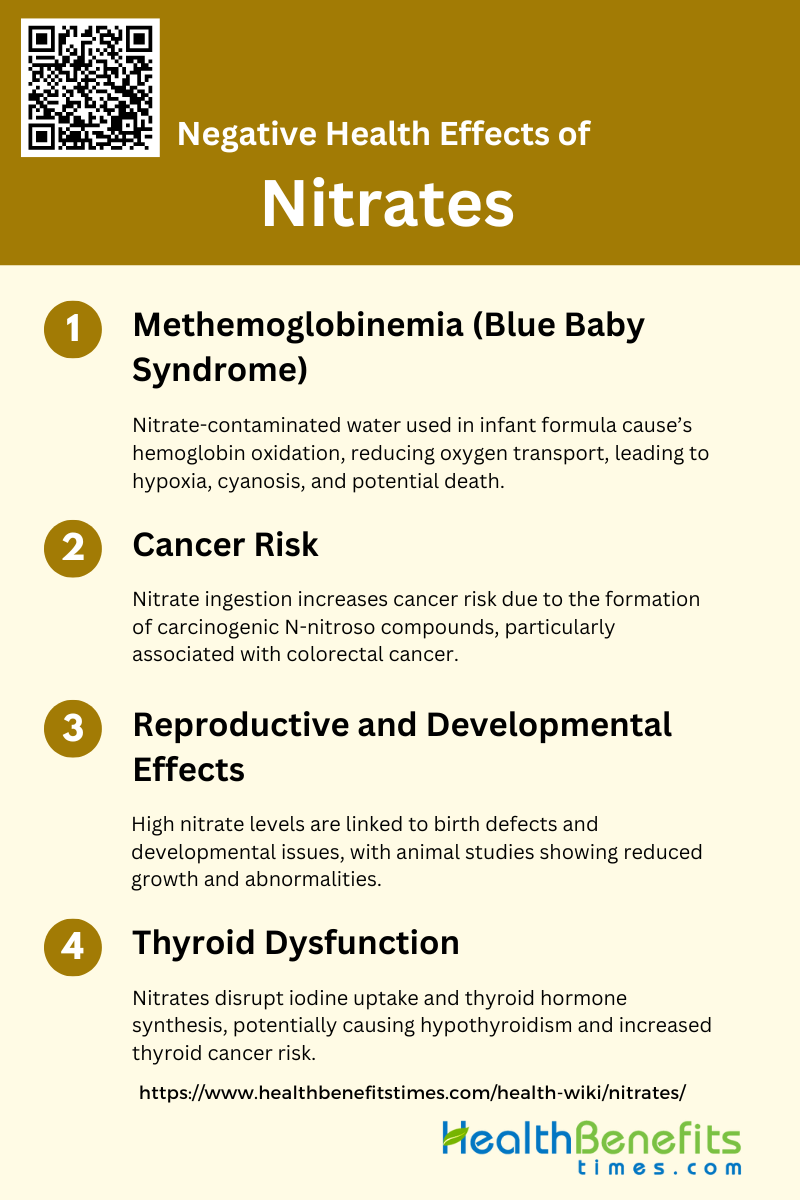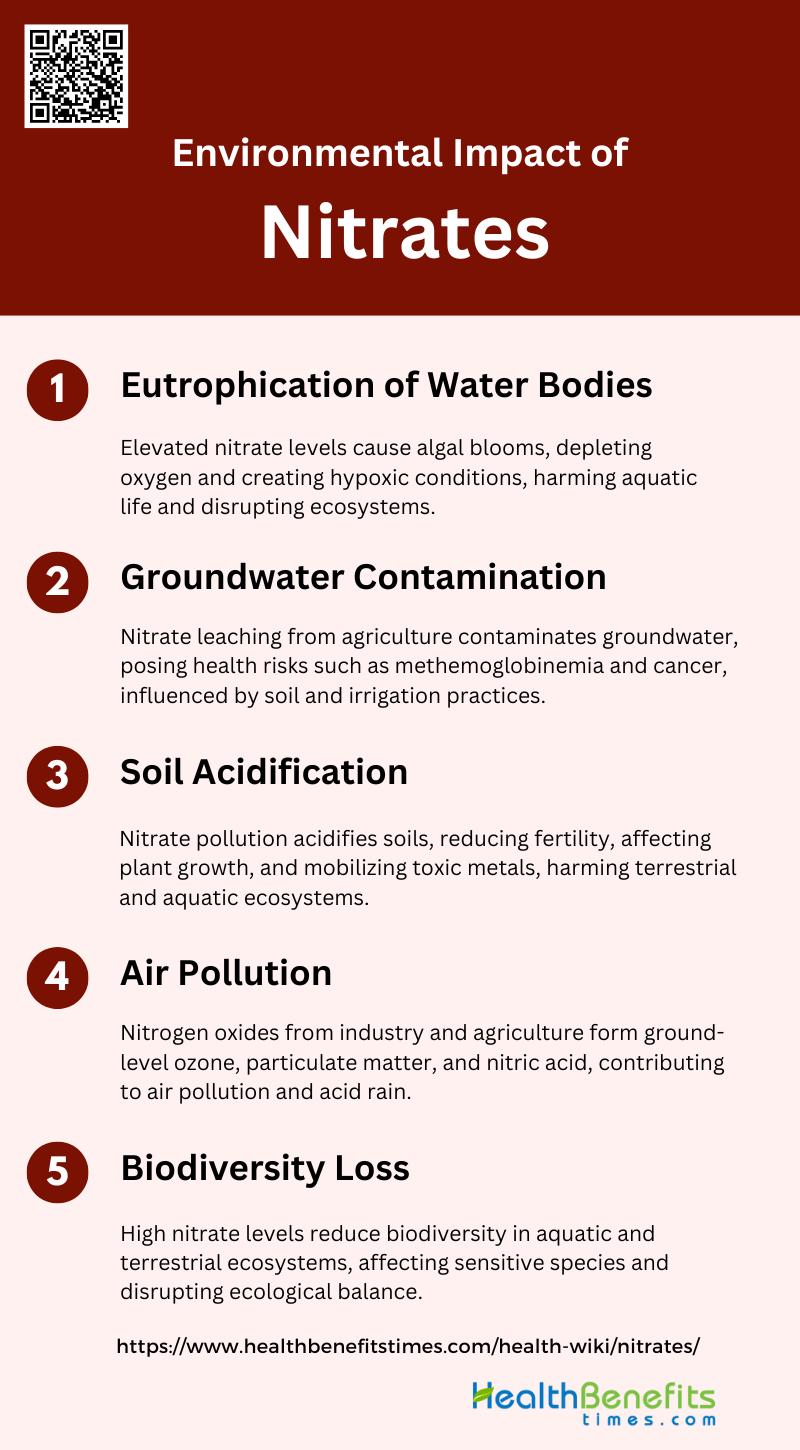Nitrates are inorganic compounds composed of one nitrogen atom and three oxygen atoms, represented by the chemical formula NO₃⁻. They occur naturally in the environment, particularly in soil and water, and are essential for plant growth as they are a primary source of nitrogen. Nitrates are also found in various foods, especially leafy green vegetables like spinach and kale, and root vegetables such as beets and carrots. In the human body, nitrates can be converted into nitric oxide, which has several health benefits, including improved blood flow and reduced blood pressure. However, nitrates are also added to processed meats as preservatives, where they can form nitrosamines, compounds that have been linked to an increased risk of cancer. Thus, while naturally occurring nitrates in vegetables are generally beneficial, those added to processed foods can pose health risks if consumed in large quantities.
Chemical Composition and Structure of Nitrates
Nitrates are a class of compounds that contain the nitrate ion, NO₃⁻. These compounds are characterized by their unique chemical structure, which includes one nitrogen atom centrally bonded to three oxygen atoms. The properties and applications of nitrates are influenced by their composition and molecular arrangement, which are detailed below:
1. Explanation of the Nitrate Ion
The nitrate ion (NO₃⁻) is a polyatomic ion with a trigonal planar structure, consisting of one nitrogen atom centrally bonded to three oxygen atoms. The nitrogen atom is sp² hybridized, resulting in a bond angle of approximately 120 degrees between the oxygen atoms. The ion carries a negative charge, which is delocalized over the three oxygen atoms due to resonance, making it relatively stable. Nitrate ions are highly soluble in water and play a significant role in various chemical and biological processes, including the nitrogen cycle and as a nutrient in plant growth.
2. Structural Characteristics
Nitrate ions exhibit a trigonal planar geometry with D₃h symmetry. The nitrogen atom is bonded to three oxygen atoms, each with a bond length of approximately 1.24 Å. The resonance structure of the nitrate ion allows for the equal distribution of the negative charge across the oxygen atoms, contributing to its stability. In aqueous solutions, nitrate ions tend to form ion pairs and exhibit bidentate coordination with metal ions, as seen in complexes with thorium and neptunyl ions. The hydration shell around nitrate ions in water is anisotropic, with a significant impact on the vibrational and dipolar properties of the ion.
3. Common Forms and Compounds Containing Nitrates
Nitrates are commonly found in various forms, including salts such as sodium nitrate (NaNO₃) and potassium nitrate (KNO₃), which are widely used in fertilizers and food preservation. In ionic liquids, nitrates can form stable complexes with metal ions, such as nickel(II) and thorium, exhibiting different coordination behaviors depending on the solvent environment. Nitrates are also present in natural sources like vegetables and fruits, contributing significantly to dietary intake. Their role in food safety and potential health benefits, such as promoting cardiovascular health through nitric oxide production, has been extensively studied.
Natural Occurrence of Nitrates
They play a crucial role in the nitrogen cycle, contributing to plant growth and soil fertility. The primary sources and processes leading to the natural occurrence of nitrates are outlined below:
1. Nitrates in Soil
Nitrates in soil primarily originate from the oxidation of organic nitrogen compounds, a process significantly influenced by agricultural practices. In Runnels County, Texas, the predominant source of soil nitrates is natural soil nitrate, as identified by stable nitrogen isotope analysis. The δN15 range of natural soil nitrate was found to be +2 to +8%, distinguishing it from animal waste nitrate. Historical dryland farming practices have led to the oxidation of organic nitrogen to nitrate, which was subsequently leached into the groundwater due to changes in water table levels.
2. Nitrates in Water
Nitrates in water are mainly a result of agricultural activities, including the use of nitrogen-containing fertilizers and the presence of animal or human organic wastes. These nitrates are highly soluble and can easily migrate into groundwater and surface waters. In Runnels County, Texas, groundwater contamination with nitrates has been significant, with average concentrations reaching 250 mg/L NO3. The contamination is primarily due to the leaching of nitrates from soil into the groundwater, exacerbated by changes in farming practices and water table levels.
3. Nitrates in Plants
Plants absorb nitrates from soil water, which are then reduced to ammonia within the plant to facilitate protein synthesis. The concentration of nitrates in plants can vary, with higher levels typically found in leafy vegetables like lettuce and spinach. These variations are influenced by both biotic and abiotic factors. Human exposure to nitrates is mainly through the consumption of vegetables, making it a significant dietary component.
Industrial and Agricultural Uses of Nitrates
Nitrates play a crucial role in various industrial and agricultural applications due to their chemical properties. They are widely used in fertilizers to enhance soil fertility and crop yields. Additionally, nitrates are essential in the production of explosives, food preservation, and wastewater treatment. Here are some key uses of nitrates in these sectors:
1. Fertilizers
Nitrates play a crucial role in agricultural fertilizers, significantly enhancing crop production by providing an essential source of nitrogen. Nitrogen is a vital nutrient for plant growth, and nitrates serve as a preferred nitrogen source for many plants. They act as signaling molecules in various physiological processes necessary for growth and development. Improving nitrogen use efficiency (NUE) through better nitrate uptake, transport, and assimilation can lead to more sustainable agricultural practices, reducing costs and minimizing environmental impacts.
2. Food Preservation
Nitrates and nitrites are extensively used in the food industry, particularly for curing meat products. These compounds act as preservatives by inhibiting the growth of pathogenic microorganisms, thereby extending the shelf life of food products. Nitrite, in particular, is effective in forming heat-stable compounds with myoglobin in meat, which helps in maintaining the color and flavor of cured meats. However, the use of nitrates and nitrites is regulated due to potential health risks, such as the formation of carcinogenic nitrosamines in the stomach.
3. Explosives and Pyrotechnics
Nitrates are key components in the production of industrial explosives and pyrotechnics. Their ability to release a large amount of oxygen upon decomposition makes them ideal for these applications. Historically, nitrates have been used in gunpowder and other explosive materials, playing a significant role in both military and civilian industries. The controlled use of nitrates in explosives and pyrotechnics continues to be essential for various industrial processes and entertainment purposes.
4. Sulphuric Acid Production
Nitrates are also involved in the production of sulfuric acid, one of the most important industrial chemicals. In the contact process, nitrates can be used as a catalyst to oxidize sulfur dioxide to sulfur trioxide, which is then converted to sulfuric acid. This process is crucial for producing sulfuric acid on a large scale, which is used in numerous industrial applications, including fertilizer production, mineral processing, and chemical synthesis.
5. Photographic Film
In the photographic industry, nitrates have historically been used in the production of photographic film. Cellulose nitrate, a derivative of nitrates, was one of the first materials used for film bases due to its excellent transparency and flexibility. However, due to its flammability and instability, cellulose nitrate has largely been replaced by safer alternatives. Despite this, the historical significance of nitrates in the development of photography remains noteworthy.
6. Metal Hardening
Nitrates are used in the metal hardening process, particularly in nitriding, where nitrogen is diffused into the surface of a metal to create a hard, wear-resistant layer. This process enhances the durability and lifespan of metal components, making them suitable for high-stress applications such as in the automotive and aerospace industries. The use of nitrates in metal hardening is a critical aspect of modern manufacturing, contributing to the production of high-performance materials.
7. Glass and Ceramics
In the glass and ceramics industry, nitrates are used as fluxing agents to lower the melting point of raw materials, facilitating the formation of glass and ceramic products. They help in achieving the desired properties in the final products, such as clarity, strength, and thermal resistance. The incorporation of nitrates in the manufacturing process is essential for producing high-quality glass and ceramic items used in various applications, from household goods to advanced technological devices.
Health Implications of Nitrates
Nitrates have significant health implications that can be both beneficial and harmful. While they are essential for various bodily functions, excessive intake can lead to serious health issues. Here are some key health implications of nitrates:
1. Cardiovascular Benefits
Dietary nitrate, primarily found in vegetables, has been shown to significantly benefit cardiovascular health. Nitrate is converted to nitric oxide (NO) in the body, which plays a crucial role in maintaining vascular function. Studies have demonstrated that nitrate supplementation can reduce blood pressure, improve endothelial function, and enhance blood flow. Additionally, nitrate intake has been linked to reduced arterial stiffness and improved platelet function, which are critical for cardiovascular health. These benefits are particularly pronounced in older adults, who experience greater reductions in blood pressure following nitrate supplementation.
2. Exercise Performance
Nitrate supplementation has been associated with improved exercise performance, particularly in clinical populations with cardiovascular diseases. It enhances muscle oxygenation and reduces the oxygen cost of exercise, thereby improving exercise tolerance. In metabolic syndrome patients, nitrate intake has been shown to upregulate antioxidant and mitochondrial dynamics genes, which are crucial for efficient energy production during exercise. However, the ergogenic benefits in healthy athletes are less clear, with variability in results due to differences in dosing regimens and participant fitness levels.
3. Cognitive Function
Nitrate-rich foods, such as beetroot and spinach, have been linked to improved cognitive function due to their role in enhancing nitric oxide production. NO is essential for cerebrovascular health and cognitive processes. Studies have shown that nitrate supplementation can improve reaction times and cognitive performance in tasks such as the Stroop test. Given the association between cardiovascular health and cognitive function, dietary nitrate may also help lower the risk of cognitive decline and dementia by improving overall vascular health.
4. Anti-Inflammatory Effects
Nitrate supplementation has demonstrated significant anti-inflammatory effects, which are beneficial for both cardiovascular health and exercise recovery. In metabolic syndrome patients, nitrate intake attenuates the pro-inflammatory response to exercise and reduces the production of inflammatory cytokines such as TNF-α. Additionally, nitrate has been shown to modulate immune cell function and reduce chronic low-grade inflammation, which is a key factor in the development of cardiovascular diseases. These anti-inflammatory properties make nitrate a valuable dietary component for maintaining overall health and preventing disease.
Negative Health Effects of Nitrates
While nitrates are naturally occurring compounds found in various foods and water sources, excessive exposure can lead to several adverse health effects. High nitrate levels are particularly concerning for vulnerable populations such as infants and pregnant women. Here is some of the key negative health effects associated with nitrates:
1. Methemoglobinemia (Blue Baby Syndrome)
Methemoglobinemia, often referred to as Blue Baby Syndrome, is a condition where nitrate-contaminated drinking water is used to prepare infant formula, leading to the oxidation of hemoglobin to methemoglobin, which cannot carry oxygen effectively. This results in hypoxia and cyanosis, manifesting as a blue-gray skin color in affected infants. Severe cases can progress rapidly to coma and death if not treated promptly. Infants are particularly vulnerable due to their higher water intake relative to body weight and lower enzymatic activity to reduce methemoglobin back to hemoglobin.
2. Cancer Risk
Nitrate ingestion has been associated with an increased risk of certain cancers due to the endogenous formation of N-nitroso compounds, which are known carcinogens. Epidemiological studies have shown a significant association between nitrate exposures and colorectal, bladder, and breast cancers, with the strongest evidence for colorectal cancer. The formation of N-nitroso compounds is influenced by various factors, including diet and individual physiology, necessitating further research to clarify these associations.
3. Reproductive and Developmental Effects
Exposure to nitrates has been linked to adverse reproductive outcomes, including birth defects and developmental issues. Studies have suggested an increased risk of neural tube defects and other congenital anomalies when nitrate levels in drinking water exceed regulatory limits. Animal studies have shown that high nitrate exposure can lead to reduced growth and developmental abnormalities, although human data are less conclusive and require further investigation.
4. Thyroid Dysfunction
Nitrates can act as endocrine disruptors, interfering with iodine uptake and thyroid hormone synthesis, potentially leading to hypothyroidism. Animal studies have demonstrated significant anti-thyroid effects at high nitrate exposure levels, including decreased serum thyroid hormone levels and histological changes in the thyroid gland. While human studies have not consistently shown a significant association between nitrate exposure and thyroid dysfunction, some cohort studies have indicated a potential link between higher nitrite exposure and increased thyroid cancer risk. Further research is needed to elucidate these effects in humans.
Environmental Impact of Nitrates
Nitrates have significant environmental consequences when they enter natural ecosystems. They contribute to water pollution, leading to issues such as eutrophication and harmful algal blooms. Here are some key environmental impacts of nitrates:
1. Eutrophication of Water Bodies
Nitrate pollution is a significant driver of eutrophication in aquatic ecosystems. Elevated nitrate levels stimulate the growth of primary producers, such as algae and cyanobacteria, leading to dense algal blooms. These blooms can deplete oxygen levels in the water, causing hypoxic or anoxic conditions that are detrimental to aquatic life. The resulting decline in dissolved oxygen can lead to extensive kills of invertebrates and fish, disrupting the entire aquatic food web. Additionally, the proliferation of toxic algae, such as cyanobacteria, can further exacerbate the negative impacts on aquatic organisms and human health.
2. Groundwater Contamination
Nitrate leaching from agricultural lands is a major source of groundwater contamination. Excessive use of nitrogenous fertilizers and improper management of livestock manure contribute to high nitrate concentrations in groundwater, posing a threat to human health. Nitrate-contaminated drinking water can cause methemoglobinemia, or “blue baby syndrome,” in infants and has been linked to various cancers and other health issues. The movement of nitrate through soil and its eventual percolation into groundwater is influenced by factors such as soil texture, precipitation, and irrigation practices.
3. Soil Acidification
Nitrate pollution can also lead to soil acidification, particularly in ecosystems with low acid-neutralizing capacity. The deposition of nitric acid (HNO3) from atmospheric sources, primarily due to unchecked NOx emissions, has become a significant contributor to the acidification of soils and freshwater systems. Acidification can have adverse effects on soil health, reducing its fertility and affecting the growth of plants. It can also lead to the mobilization of toxic metals, further harming terrestrial and aquatic ecosystems.
4. Air Pollution
Nitrate pollution is closely linked to air pollution through the emission of nitrogen oxides (NOx) from industrial and agricultural activities. These emissions contribute to the formation of ground-level ozone and particulate matter, which are harmful to human health and the environment. Additionally, NOx emissions can lead to the formation of nitric acid in the atmosphere, contributing to acid rain and the subsequent acidification of soils and water bodies. Effective management of NOx emissions is crucial to mitigate these environmental impacts.
5. Biodiversity Loss
The presence of high nitrate levels in aquatic and terrestrial ecosystems can lead to significant biodiversity loss. In aquatic systems, nitrate-induced eutrophication and the resulting hypoxic conditions can cause the decline of sensitive species, such as charophytes, which are important for maintaining ecosystem function and biodiversity. In terrestrial ecosystems, soil acidification and the mobilization of toxic metals can negatively impact plant and microbial communities, leading to a loss of biodiversity. The complex interactions between nitrate pollution and other environmental stressors further compound these negative effects, necessitating a holistic approach to conservation efforts.
Regulations and Guidelines of Nitrates
Nitrates are subject to various regulations and guidelines to ensure public health and environmental safety. These standards are set by governmental and international bodies to control nitrate levels in drinking water, food, and agricultural practices. Here are some key regulations and guidelines related to nitrates:
1. Government Regulations on Nitrate Levels
Government regulations on nitrate levels are primarily designed to protect public health, particularly vulnerable populations such as infants. The U.S. Environmental Protection Agency (EPA) has set a maximum contaminant level (MCL) of 10 mg/L for nitrate in drinking water to prevent methemoglobinemia, a condition that impairs the blood’s ability to carry oxygen, especially in infants. Similarly, the World Health Organization (WHO) has established guidelines recommending the same limit to ensure safety. These regulations are based on extensive research linking high nitrate levels to various health risks, including certain cancers and adverse reproductive outcomes.
2. Safety Guidelines for Nitrate Use
Safety guidelines for nitrate use emphasize minimizing exposure to high nitrate levels, particularly in drinking water and food. The WHO and other health organizations recommend maintaining nitrate concentrations below 10 mg/L in drinking water to prevent health issues such as methemoglobinemia in infants and potential long-term effects like cancer and thyroid disease. Additionally, guidelines suggest monitoring and controlling nitrate levels in agricultural practices to prevent contamination of water resources. For sensitive freshwater species, a maximum nitrate concentration of 2 mg NO3-N/L is recommended to protect aquatic life from nitrate toxicity.
3. Monitoring and Compliance
Monitoring and compliance with nitrate regulations involve regular testing of water supplies and food products to ensure nitrate levels remain within safe limits. Studies have shown that nitrate concentrations in foodstuffs, particularly leafy vegetables and certain seafood, can be high, necessitating stringent monitoring. Official controls over a five-year period have highlighted the need for new legal limits and more comprehensive monitoring to address gaps in current legislation. Compliance with these regulations is crucial to prevent adverse health outcomes and protect both human and environmental health.






